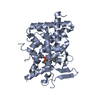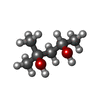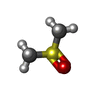+ Open data
Open data
- Basic information
Basic information
| Entry | Database: PDB / ID: 6tfi | ||||||
|---|---|---|---|---|---|---|---|
| Title | PXR IN COMPLEX WITH THROMBIN INHIBITOR COMPOUND 17 | ||||||
 Components Components | Nuclear receptor subfamily 1 group I member 2,Nuclear receptor coactivator 1 | ||||||
 Keywords Keywords |  TRANSCRIPTION / PXR / TRANSCRIPTION / PXR /  SRC-1 / CYP3A4 INDUCTION / PK OPTIMIZATION SRC-1 / CYP3A4 INDUCTION / PK OPTIMIZATION | ||||||
| Function / homology |  Function and homology information Function and homology informationxenobiotic transport / labyrinthine layer morphogenesis / regulation of thyroid hormone mediated signaling pathway / positive regulation of transcription from RNA polymerase II promoter by galactose / positive regulation of female receptivity / intermediate filament cytoskeleton / hypothalamus development / male mating behavior / NR1H2 & NR1H3 regulate gene expression to control bile acid homeostasis / steroid metabolic process ...xenobiotic transport / labyrinthine layer morphogenesis / regulation of thyroid hormone mediated signaling pathway / positive regulation of transcription from RNA polymerase II promoter by galactose / positive regulation of female receptivity / intermediate filament cytoskeleton / hypothalamus development / male mating behavior / NR1H2 & NR1H3 regulate gene expression to control bile acid homeostasis / steroid metabolic process / cellular response to Thyroglobulin triiodothyronine /  estrous cycle / Synthesis of bile acids and bile salts / Endogenous sterols / Synthesis of bile acids and bile salts via 27-hydroxycholesterol / Synthesis of bile acids and bile salts via 7alpha-hydroxycholesterol / xenobiotic catabolic process / nuclear retinoid X receptor binding / response to retinoic acid / estrous cycle / Synthesis of bile acids and bile salts / Endogenous sterols / Synthesis of bile acids and bile salts via 27-hydroxycholesterol / Synthesis of bile acids and bile salts via 7alpha-hydroxycholesterol / xenobiotic catabolic process / nuclear retinoid X receptor binding / response to retinoic acid /  histone acetyltransferase activity / regulation of cellular response to insulin stimulus / Recycling of bile acids and salts / histone acetyltransferase activity / regulation of cellular response to insulin stimulus / Recycling of bile acids and salts /  histone acetyltransferase / cellular response to hormone stimulus / NR1H3 & NR1H2 regulate gene expression linked to cholesterol transport and efflux / positive regulation of adipose tissue development / peroxisome proliferator activated receptor signaling pathway / RORA activates gene expression / histone acetyltransferase / cellular response to hormone stimulus / NR1H3 & NR1H2 regulate gene expression linked to cholesterol transport and efflux / positive regulation of adipose tissue development / peroxisome proliferator activated receptor signaling pathway / RORA activates gene expression /  lactation / positive regulation of neuron differentiation / Regulation of lipid metabolism by PPARalpha / xenobiotic metabolic process / cerebellum development / BMAL1:CLOCK,NPAS2 activates circadian gene expression / SUMOylation of transcription cofactors / Activation of gene expression by SREBF (SREBP) / nuclear receptor coactivator activity / response to progesterone / nuclear estrogen receptor binding / hippocampus development / lactation / positive regulation of neuron differentiation / Regulation of lipid metabolism by PPARalpha / xenobiotic metabolic process / cerebellum development / BMAL1:CLOCK,NPAS2 activates circadian gene expression / SUMOylation of transcription cofactors / Activation of gene expression by SREBF (SREBP) / nuclear receptor coactivator activity / response to progesterone / nuclear estrogen receptor binding / hippocampus development /  nuclear receptor binding / RNA polymerase II transcription regulatory region sequence-specific DNA binding / Heme signaling / SUMOylation of intracellular receptors / mRNA transcription by RNA polymerase II / Transcriptional activation of mitochondrial biogenesis / PPARA activates gene expression / Cytoprotection by HMOX1 / cerebral cortex development / Transcriptional regulation of white adipocyte differentiation / Nuclear Receptor transcription pathway / RNA polymerase II transcription regulator complex / nuclear receptor binding / RNA polymerase II transcription regulatory region sequence-specific DNA binding / Heme signaling / SUMOylation of intracellular receptors / mRNA transcription by RNA polymerase II / Transcriptional activation of mitochondrial biogenesis / PPARA activates gene expression / Cytoprotection by HMOX1 / cerebral cortex development / Transcriptional regulation of white adipocyte differentiation / Nuclear Receptor transcription pathway / RNA polymerase II transcription regulator complex /  nuclear receptor activity / male gonad development / sequence-specific double-stranded DNA binding / nuclear receptor activity / male gonad development / sequence-specific double-stranded DNA binding /  Circadian Clock / response to estradiol / HATs acetylate histones / DNA-binding transcription activator activity, RNA polymerase II-specific / Estrogen-dependent gene expression / Circadian Clock / response to estradiol / HATs acetylate histones / DNA-binding transcription activator activity, RNA polymerase II-specific / Estrogen-dependent gene expression /  transcription regulator complex / transcription regulator complex /  transcription coactivator activity / transcription coactivator activity /  cell differentiation / cell differentiation /  nuclear body / nuclear body /  protein dimerization activity / DNA-binding transcription factor activity, RNA polymerase II-specific / positive regulation of apoptotic process / RNA polymerase II cis-regulatory region sequence-specific DNA binding / negative regulation of DNA-templated transcription / protein dimerization activity / DNA-binding transcription factor activity, RNA polymerase II-specific / positive regulation of apoptotic process / RNA polymerase II cis-regulatory region sequence-specific DNA binding / negative regulation of DNA-templated transcription /  chromatin binding / chromatin binding /  chromatin / regulation of DNA-templated transcription / positive regulation of gene expression / positive regulation of DNA-templated transcription / negative regulation of transcription by RNA polymerase II / chromatin / regulation of DNA-templated transcription / positive regulation of gene expression / positive regulation of DNA-templated transcription / negative regulation of transcription by RNA polymerase II /  signal transduction / positive regulation of transcription by RNA polymerase II / protein-containing complex / zinc ion binding / signal transduction / positive regulation of transcription by RNA polymerase II / protein-containing complex / zinc ion binding /  nucleoplasm / nucleoplasm /  nucleus / nucleus /  plasma membrane / plasma membrane /  cytosol cytosolSimilarity search - Function | ||||||
| Biological species |   Homo sapiens (human) Homo sapiens (human) | ||||||
| Method |  X-RAY DIFFRACTION / X-RAY DIFFRACTION /  SYNCHROTRON / SYNCHROTRON /  FOURIER SYNTHESIS / Resolution: 1.85 Å FOURIER SYNTHESIS / Resolution: 1.85 Å | ||||||
 Authors Authors | Hillig, R.C. / Puetter, V. | ||||||
 Citation Citation |  Journal: J.Med.Chem. / Year: 2020 Journal: J.Med.Chem. / Year: 2020Title: Design, Synthesis, and Pharmacological Characterization of a Neutral, Non-Prodrug Thrombin Inhibitor with Good Oral Pharmacokinetics. Authors: Hillisch, A. / Gericke, K.M. / Allerheiligen, S. / Roehrig, S. / Schaefer, M. / Tersteegen, A. / Schulz, S. / Lienau, P. / Gnoth, M. / Puetter, V. / Hillig, R.C. / Heitmeier, S. | ||||||
| History |
|
- Structure visualization
Structure visualization
| Structure viewer | Molecule:  Molmil Molmil Jmol/JSmol Jmol/JSmol |
|---|
- Downloads & links
Downloads & links
- Download
Download
| PDBx/mmCIF format |  6tfi.cif.gz 6tfi.cif.gz | 272.5 KB | Display |  PDBx/mmCIF format PDBx/mmCIF format |
|---|---|---|---|---|
| PDB format |  pdb6tfi.ent.gz pdb6tfi.ent.gz | 218.9 KB | Display |  PDB format PDB format |
| PDBx/mmJSON format |  6tfi.json.gz 6tfi.json.gz | Tree view |  PDBx/mmJSON format PDBx/mmJSON format | |
| Others |  Other downloads Other downloads |
-Validation report
| Arichive directory |  https://data.pdbj.org/pub/pdb/validation_reports/tf/6tfi https://data.pdbj.org/pub/pdb/validation_reports/tf/6tfi ftp://data.pdbj.org/pub/pdb/validation_reports/tf/6tfi ftp://data.pdbj.org/pub/pdb/validation_reports/tf/6tfi | HTTPS FTP |
|---|
-Related structure data
| Related structure data |  6zugC  6zuhC  6zunC  6zuuC  6zuwC  6zuxC  6zv7C  6zv8C  3hvlS S: Starting model for refinement C: citing same article ( |
|---|---|
| Similar structure data |
- Links
Links
- Assembly
Assembly
| Deposited unit | 
| ||||||||||||||||||
|---|---|---|---|---|---|---|---|---|---|---|---|---|---|---|---|---|---|---|---|
| 1 | 
| ||||||||||||||||||
| 2 | 
| ||||||||||||||||||
| Unit cell |
| ||||||||||||||||||
| Noncrystallographic symmetry (NCS) | NCS domain:
NCS domain segments: Component-ID: 0 / Ens-ID: 1 / Beg auth comp-ID: GLY / Beg label comp-ID: GLY / End auth comp-ID: GLY / End label comp-ID: GLY / Refine code: 0 / Auth seq-ID: 142 - 459 / Label seq-ID: 24 - 341
|
- Components
Components
-Protein , 1 types, 2 molecules AB
| #1: Protein | Mass: 39184.035 Da / Num. of mol.: 2 / Mutation: K129G Source method: isolated from a genetically manipulated source Details: PXR, RESIDUES 129-434, K129G IS A CLONING ARTIFACT; LINKER; SRC-1, RESIDUES 678-700,PXR, RESIDUES 129-434, K129G IS A CLONING ARTIFACT; LINKER; SRC-1, RESIDUES 678-700 Source: (gene. exp.)   Homo sapiens (human) / Gene: NR1I2, PXR, NCOA1, BHLHE74, SRC1 / Production host: Homo sapiens (human) / Gene: NR1I2, PXR, NCOA1, BHLHE74, SRC1 / Production host:   Escherichia coli (E. coli) Escherichia coli (E. coli)References: UniProt: O75469, UniProt: Q15788,  histone acetyltransferase histone acetyltransferase |
|---|
-Non-polymers , 6 types, 371 molecules 










| #2: Chemical | ChemComp-GOL /  Glycerol Glycerol#3: Chemical |  2-Methyl-2,4-pentanediol 2-Methyl-2,4-pentanediol#4: Chemical | ChemComp-PO4 / |  Phosphate Phosphate#5: Chemical |  Dimethyl sulfoxide Dimethyl sulfoxide#6: Chemical | ChemComp-N6H / [ | #7: Water | ChemComp-HOH / |  Water Water |
|---|
-Details
| Has ligand of interest | Y |
|---|
-Experimental details
-Experiment
| Experiment | Method:  X-RAY DIFFRACTION / Number of used crystals: 1 X-RAY DIFFRACTION / Number of used crystals: 1 |
|---|
- Sample preparation
Sample preparation
| Crystal | Density Matthews: 2.56 Å3/Da / Density % sol: 51.94 % |
|---|---|
Crystal grow | Temperature: 277 K / Method: vapor diffusion, hanging drop / pH: 8 Details: 1 MICROLITER PROTEIN AT 12.1 MG/ML (IN 20 MILLIMOLAR TRIS PH 7.8, 250 MILLIMOLAR NACL, 2.5 MILLIMOLAR EDTA, 5% (V/V) GLYCEROL, 5 MM DTT), PREINCUBATED WITH 25 MILLIMOLAR COMPOUND 17 (FROM ...Details: 1 MICROLITER PROTEIN AT 12.1 MG/ML (IN 20 MILLIMOLAR TRIS PH 7.8, 250 MILLIMOLAR NACL, 2.5 MILLIMOLAR EDTA, 5% (V/V) GLYCEROL, 5 MM DTT), PREINCUBATED WITH 25 MILLIMOLAR COMPOUND 17 (FROM 500 MILLIMOLAR STOCK IN DMSO) for 24 hours at 277 K, MIXED WITH 1 MICROLITER OF RESERVOIR (100 MILLIMOLAR IMIDAZOLE PH 8.0, 20 % (V/V) MPD). CRYO BUFFER 100 MILLIMOLAR IMIDAZOLE PH 8.0, 30 % (V/V) MPD |
-Data collection
| Diffraction | Mean temperature: 100 K / Serial crystal experiment: N |
|---|---|
| Diffraction source | Source:  SYNCHROTRON / Site: SYNCHROTRON / Site:  BESSY BESSY  / Beamline: 14.1 / Wavelength: 0.91841 Å / Beamline: 14.1 / Wavelength: 0.91841 Å |
| Detector | Type: MARMOSAIC 225 mm CCD / Detector: CCD / Date: Oct 13, 2010 |
| Radiation | Protocol: SINGLE WAVELENGTH / Monochromatic (M) / Laue (L): M / Scattering type: x-ray |
| Radiation wavelength | Wavelength : 0.91841 Å / Relative weight: 1 : 0.91841 Å / Relative weight: 1 |
| Reflection | Resolution: 1.85→44.48 Å / Num. obs: 67925 / % possible obs: 97.9 % / Redundancy: 5.07 % / Biso Wilson estimate: 39.61 Å2 / CC1/2: 0.999 / Rrim(I) all: 0.059 / Rsym value: 0.053 / Net I/σ(I): 17.15 |
| Reflection shell | Resolution: 1.85→1.96 Å / Redundancy: 5 % / Mean I/σ(I) obs: 1.82 / Num. unique obs: 10924 / CC1/2: 0.668 / Rrim(I) all: 0.977 / Rsym value: 0.878 / % possible all: 98.7 |
- Processing
Processing
| Software |
| ||||||||||||||||||||||||||||||||||||||||||||||||||||||||||||||||||||||||||||||||||||||||||||||||||||||||||||||||||||||||||||||||||||||||||||||||||||||||||||||||||||||||||||||||||||||
|---|---|---|---|---|---|---|---|---|---|---|---|---|---|---|---|---|---|---|---|---|---|---|---|---|---|---|---|---|---|---|---|---|---|---|---|---|---|---|---|---|---|---|---|---|---|---|---|---|---|---|---|---|---|---|---|---|---|---|---|---|---|---|---|---|---|---|---|---|---|---|---|---|---|---|---|---|---|---|---|---|---|---|---|---|---|---|---|---|---|---|---|---|---|---|---|---|---|---|---|---|---|---|---|---|---|---|---|---|---|---|---|---|---|---|---|---|---|---|---|---|---|---|---|---|---|---|---|---|---|---|---|---|---|---|---|---|---|---|---|---|---|---|---|---|---|---|---|---|---|---|---|---|---|---|---|---|---|---|---|---|---|---|---|---|---|---|---|---|---|---|---|---|---|---|---|---|---|---|---|---|---|---|---|
| Refinement | Method to determine structure : :  FOURIER SYNTHESIS FOURIER SYNTHESISStarting model: 3HVL Resolution: 1.85→44.48 Å / Cor.coef. Fo:Fc: 0.968 / Cor.coef. Fo:Fc free: 0.956 / SU B: 5.569 / SU ML: 0.08 / Cross valid method: THROUGHOUT / ESU R: 0.113 / ESU R Free: 0.108 / Stereochemistry target values: MAXIMUM LIKELIHOOD / Details: HYDROGENS HAVE BEEN ADDED IN THE RIDING POSITIONS
| ||||||||||||||||||||||||||||||||||||||||||||||||||||||||||||||||||||||||||||||||||||||||||||||||||||||||||||||||||||||||||||||||||||||||||||||||||||||||||||||||||||||||||||||||||||||
| Solvent computation | Ion probe radii: 0.8 Å / Shrinkage radii: 0.8 Å / VDW probe radii: 1.2 Å / Solvent model: MASK | ||||||||||||||||||||||||||||||||||||||||||||||||||||||||||||||||||||||||||||||||||||||||||||||||||||||||||||||||||||||||||||||||||||||||||||||||||||||||||||||||||||||||||||||||||||||
| Displacement parameters | Biso mean: 41.918 Å2
| ||||||||||||||||||||||||||||||||||||||||||||||||||||||||||||||||||||||||||||||||||||||||||||||||||||||||||||||||||||||||||||||||||||||||||||||||||||||||||||||||||||||||||||||||||||||
| Refinement step | Cycle: LAST / Resolution: 1.85→44.48 Å
| ||||||||||||||||||||||||||||||||||||||||||||||||||||||||||||||||||||||||||||||||||||||||||||||||||||||||||||||||||||||||||||||||||||||||||||||||||||||||||||||||||||||||||||||||||||||
| Refine LS restraints |
|
 Movie
Movie Controller
Controller













 PDBj
PDBj















